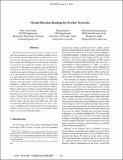| dc.contributor.author | Cheng, Bow-Nan | |
| dc.contributor.author | Yuksel, Murat | |
| dc.contributor.author | Kalyanaraman, Shivkumar | |
| dc.date.accessioned | 2010-10-07T17:27:47Z | |
| dc.date.available | 2010-10-07T17:27:47Z | |
| dc.date.issued | 2009-10 | |
| dc.date.submitted | 2009-09 | |
| dc.identifier.isbn | 978-1-4244-5066-4 | |
| dc.identifier.isbn | 978-1-4244-5067-1 | |
| dc.identifier.uri | http://hdl.handle.net/1721.1/58947 | |
| dc.description.abstract | The enormous interest for peer-to-peer systems in recent years has prompted research into finding scalable and robust seeding and searching methods to support these overlay networks. Routing and search in these overlay networks have ranged from flooding-based unstructured techniques to structured ones mainly for popular and rate items respectively. In this paper, we propose a new method of establishing a virtual structure and introduce a technique to scalably route packets through an unstructured overlay network. We introduce virtual direction routing (VDR). VDR is a lightweight and scalable overlay network routing protocol that uses the concept of virtual directions to efficiently perform node information seeding and lookup. State information is replicated at nodes along virtual orthogonal lines originating from each node and periodically updated. When a path lookup is initiated, instead of flooding the network, query packets are also forwarded along virtual orthogonal lines until an intersection with the seeded state occurs. We show that VDR achieves high reachability with relatively low seed and search packet TTL even under high network churn. We also show that VDR scales well without imposing DHT-like graph structures (e.g., trees, rings, torus, coordinate-space) and the path stretch compared to random-walk protocols is very good. The tradeoff is added latency by choosing suboptimal paths. | en_US |
| dc.description.sponsorship | National Science Foundation (U.S.) (grant 0627039) | en_US |
| dc.description.sponsorship | National Science Foundation (U.S.) (grant 0721452) | en_US |
| dc.description.sponsorship | National Science Foundation (U.S.) (grant 0721612) | en_US |
| dc.description.sponsorship | National Science Foundation (U.S.) (grant 0230787) | en_US |
| dc.language.iso | en_US | |
| dc.publisher | Institute of Electrical and Electronics Engineers | en_US |
| dc.relation.isversionof | http://dx.doi.org/10.1109/P2P.2009.5284516 | en_US |
| dc.rights | Article is made available in accordance with the publisher's policy and may be subject to US copyright law. Please refer to the publisher's site for terms of use. | en_US |
| dc.source | IEEE | en_US |
| dc.title | Virtual Direction Routing for Overlay Networks | en_US |
| dc.type | Article | en_US |
| dc.identifier.citation | Bow-Nan Cheng, M. Yuksel, and S. Kalyanaraman. “Virtual Direction Routing for overlay networks.” Peer-to-Peer Computing, 2009. P2P '09. IEEE Ninth International Conference on. 2009. 61-70. © Copyright 2009 IEEE | en_US |
| dc.contributor.department | Lincoln Laboratory | en_US |
| dc.contributor.approver | Cheng, Bow-Nan | |
| dc.contributor.mitauthor | Cheng, Bow-Nan | |
| dc.relation.journal | Proceedings of the IEEE Ninth International Conference on Peer-to-Peer Computing, 2009 | en_US |
| dc.eprint.version | Final published version | en_US |
| dc.type.uri | http://purl.org/eprint/type/JournalArticle | en_US |
| eprint.status | http://purl.org/eprint/status/PeerReviewed | en_US |
| dspace.orderedauthors | Cheng, Bow-Nan; Yuksel, Murat; Kalyanaraman, Shivkumar | en |
| mit.license | PUBLISHER_POLICY | en_US |
| mit.metadata.status | Complete | |
